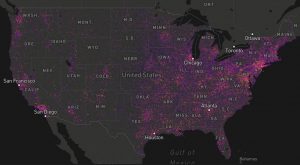Hint: It’s Not Just MPG
To determine how clean your commute is in relation to the national and local averages, you have to consider a few points. Gas vehicles, electric vehicles and hybrid vehicles will obviously each make different impacts as their drivers take their daily commutes, and the distance you travel to and from your home each day will also need to be considered.
However, research suggests that the most important facet for gas vehicles to take into account is not their MPG, or even the distance they travel each day, but the length of time spent commuting.
According to the Environmental Defense Fund, an idling vehicle can produce just as much pollution as a driving one. Which means every one of those gas vehicles sitting in rush hour traffic is stacking up emissions, even though the miles on the odometer might not be climbing.
So how long is your commute, and how does that compare to the national average, and the average in your community? The folks at Auto Accessories Garage have come up with one way to find out. Gleaning data from the US Census Bureau, they put together this interactive map which takes your zip code and commute time, and compares them at a zip, city, and state level.
The map also calculates how much drive time you’re saving (or wasting) in your current commuting situation compared to the national average. The results may have you looking for new shortcuts along your route.

While it’s no secret that carpooling or using transit can have a big impact on the environment, data like this make is crystally clear—especially when you consider it reduces what could be two, three, or even more commutes into one.
How Much Fuel is on the Line?
Another consideration beyond time is, how much fuel is on the line when it comes to lengthy commutes? The Idaho National Lab calculates that the average gas vehicle gets 25.5 mpg, at an average cost of $2 per gallon. That comes out to about eight cents per mile in perfect conditions, but as we all know, rush hour commuting is about as far from ‘perfect conditions’ as you can get.
This is where hybrids and fully electric vehicles can provide a valuable service. At a standstill, an EV is still using some electricity that will need to be refilled. It’s a small problem in areas where utilities are affordable, but electricity prices around the United States are wildly inconsistent.
For example, while residents of Washington pay about $25 for enough electricity to propel their EVs 1,000 miles, residents of Hawaii would pay more than $100 for the same amount of juice.
As national trends swing further in favor of hybrid and electric vehicles, the exorbitant amount of lost fuel due to stop-and-go traffic will continue to reduce. But even in an all-electric society, carpooling would still be a virtue for a number of reasons. Not the least of which, that it could reduce commute times for everybody. And who wouldn’t want that?
Related Stories You Might Enjoy!
News: 10 Worst Commutes

It was never ‘mpg’ but for a different reason that outlined in this article. Even just using the term mpg hides the truth from readers. The more relevant statistic is fuel consumption, or gallons/mile, which is directly proportional to fuel used while driving. The mathematical inverse, mpg, is a hyperbolic relationship to fuel used and it hides the fact that we spent lots of reporting time and energy about moving vehicles from 40 to 50 mpg when what we should be doing is tackling the vehicles that are at 10 mpg, 15 mpg, or even 20 mpg. Strike the phrase fuel economy and mpg from your dictionary and start using fuel consumption. The rest of the world has already done this. The U.S. is the only backward holdout.
Also, and I am a big xEV advocate, there is an all electric range lie when talking about PHEVs and EREVs. Drive any EREV or PHEV in less than ideal conditions (hot, cold, heavy traction load) and the engine comes on. No one ever publishes analysis reports about that fuel use, but it’s not zero.
Also, while idling does use fuel, the fuel rate is lower than highway propulsion levels of output (up to 5X lower in some vehicles) so the idle time has to be considerable compared to the propulsion time to have a large impact. That said, it is easy to identify idle fuel use as wasted energy, but there are lots more hidden areas of wasted energy, the most important of which is kinetic energy. Every vehicle on the road should at least be a hybrid with kinetic energy recovery and idle reduction.
Finally time in vehicle is too simplistic a metric. It is easy to show on a chassis dyno test that traveling from point A to B in the shortest time in a vehicle uses more fuel than a more gentle acceleration and deceleration profile, so we just have to be careful here.
@Ed,
Excellent comments! you are so right about fuel consumption vs. mpg and the need to tackle low mpg vehicles to really save fuel. It’s a shame mpg is not only the lingua francas of this country but the only term most understand about fuel efficiency. Your points are well taken and we may try to add a gal/mi figure to our upcoming vehicle tests. How would that sit with you? –ed.